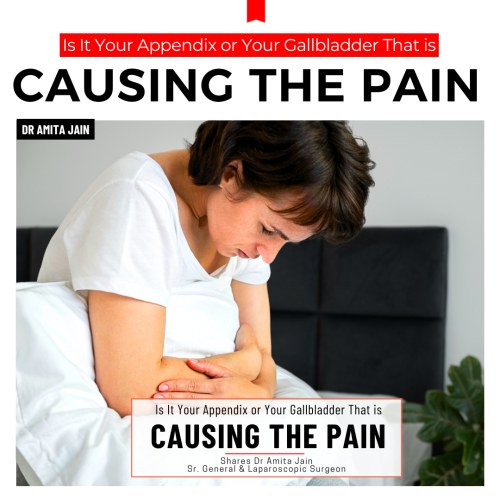Many people assume that if they eat healthily, exercise, and follow a disciplined lifestyle, their bodies will remain free from illness. But the truth is, health problems can arise unexpectedly—even in the fittest individuals. One of the most confusing and alarming issues is abdominal pain, because it can be caused by different organs.
Among the most common and serious conditions are appendicitis and gallbladder problems. Both require timely treatment, but their symptoms often overlap, making it hard to know which one is the cause.
To help clear the confusion, Dr Amita Jain, who is one of the best gallbladder stone removal surgeons and a leading general surgeon for appendicities treatment in Delhi and India, explains how to differentiate between appendix pain and gallbladder pain.
What is the Gallbladder?
The gallbladder is a small, pear-shaped organ located beneath the liver. Its role is to store bile, a fluid that helps digest fats. When you eat a heavy or fatty meal, the gallbladder contracts and releases bile into the intestine to aid digestion. Problems arise when stones, blockages, or inflammation affect this organ.
What is the Appendix?
The appendix is a small, tube-like pouch attached to the large intestine on the lower right side of the abdomen. While it was once considered a useless organ, studies now suggest it may support immunity and gut bacteria. However, when it gets inflamed, the condition—known as appendicitis—becomes a surgical emergency.
Understanding Appendicitis
Appendicitis occurs when the appendix gets blocked, inflamed, or infected. The pain usually begins near the belly button and then shifts to the lower right side of the abdomen. It becomes sharp, constant, and worsens with movement. Other symptoms include loss of appetite, nausea, vomiting, mild fever, and abdominal tenderness. Appendicitis does not improve on its own; without timely surgery, the appendix can burst and cause life-threatening infection.
Causes of Gallbladder Pain
Unlike the appendix, gallbladder pain is most commonly linked to gallstones. These are hardened deposits of bile that can block the ducts and cause sudden, intense pain known as a gallbladder attack. The pain usually occurs in the upper right abdomen, often spreading to the back or right shoulder. It typically flares up after eating a heavy or fatty meal. Other causes include:
- Bile duct stones – When stones move into the bile duct and block it, causing severe pain and even pancreatitis.
- Gallbladder inflammation (cholecystitis) – When trapped bile leads to infection, resulting in pain, fever, and nausea.
Appendix Pain vs Gallbladder Pain: Key Differences
Both appendix and gallbladder pain can be severe, but they have distinct patterns:
- Location of Pain: Appendicitis starts near the navel and shifts to the lower right abdomen. Gallbladder pain strikes the upper right abdomen and may radiate to the back or shoulder.
- Nature of Pain: Appendix pain is sharp, constant, and worsens with movement. Gallbladder pain can be sharp or cramping and often comes in waves.
- Onset of Pain: Appendicitis builds up gradually over hours without a food trigger. Gallbladder pain usually comes on suddenly, often after a fatty meal.
- Associated Symptoms: Appendicitis may cause nausea, vomiting, fever, and loss of appetite. Gallbladder attacks are often accompanied by bloating, nausea, vomiting, and sometimes jaundice.
- Progression: Appendicitis keeps getting worse until treated surgically. Gallbladder pain may last minutes to hours and sometimes subsides on its own, but recurrence is common.
Diagnosis and Treatment
- Gallbladder Issues: Diagnosed mainly through ultrasound, sometimes with CT scan, MRI, or endoscopic tests. Treatment may include medications or surgery (laparoscopic cholecystectomy) to remove the gallbladder.
- Appendicitis: Diagnosed usually with a CT scan or ultrasound. The standard treatment is surgical removal of the appendix (appendectomy).
Both appendicitis and gallbladder problems can quickly turn into medical emergencies. The key difference is that appendix pain usually begins near the belly button and shifts to the lower right abdomen, while gallbladder pain flares up in the upper right abdomen, often after fatty meals.
If you experience sudden abdominal pain, don’t ignore it. Seek immediate medical attention. Dr Amita Jain, a top laparoscopic surgeon in Delhi, India, advises that timely diagnosis and treatment can save you from serious complications and ensure a faster recovery.

Dr Amita Jain is one of India’s most distinguished and experienced female surgeons, known for her unmatched expertise in general and laparoscopic surgery. With over 29 years of surgical excellence, Dr Amita Jain has built a reputation for precision, compassionate care, and advanced surgical techniques.
Dr Amita Jain has successfully performed a wide range of complex general surgeries, including both open and minimally invasive procedures, with a strong focus on trauma care, onco-surgical techniques, and reconstructive surgeries. Her areas of specialisation include (including Gallbladder stone removal, appendix removal, hernia repair surgery, piles and fissure surgeries). She was the Professor of Surgery at the Army College of Medical Sciences and Base Hospital, Delhi Cantt. In 1994, she was commissioned asa Surgeon under the United Nations Mission in Congo. From 2020 to 2022, she worked with Bansals Hospital. Currently, Dr Amita Jain is the Senior General and Laparoscopic Surgeon at Rainbow Children Hospitals (Malviya Nagar, Delhi), Artemis Lite: Multi-Speciality Care Hospital (New Friends Colony, New Delhi) and at Rosewalk – Luxury Maternity Hospital in Delhi (Panchsheel Park, Delhi)
Call Us at +(91) 882-6615301

